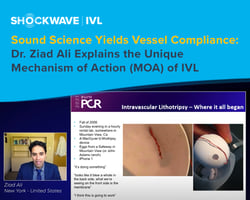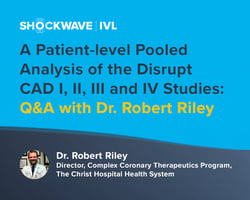New IVL Trilogy in JACC Interventions – Hear the Highlights
Learn about IVL’s unique mechanism of action in fracturing severe, superficial and deep calcium and the clinical outcomes associated with IVL in the coronary and peripheral vasculature.
Mechanism of Action Manuscript
Kereiakes DJ, et al. Principles of intravascular lithotripsy for calcific plaque modification. J Am Coll Cardiol Intv 2021;14:1275-92. https://doi.org/10.1016/j.jcin.2021.03.036
- Deep dive on the mechanism of action (MOA) of IVL, tracing the history from the treatment of renal calculi to the treatment of coronary and peripheral artery disease
- How acoustic shockwaves emitted from a balloon-based delivery system fracture superficial and deep calcium, resulting in increased arterial compliance and arterial lumen gain
- A summary of the physics, pre-clinical and clinical data, as well as future technology directions and therapeutic targets
- A reference work that answers many of the MOA questions
Patient-Level Pooled Analysis of the Disrupt CAD Studies
- Kereiakes DJ, et al. Intravascular lithotripsy for treatment of calcified coronary lesions: Patient-level pooled analysis of the Disrupt CAD studies. J Am Coll Cardiol Intv 2021;14:1337-48. https://doi.org/10.1016/j.jcin.2021.04.015.
- The largest patient-level study of IVL in the treatment of severe calcium; 628 patients, 72 sites, 12 countries
- Primary safety and effectiveness endpoints were achieved in 92.7% and 92.4% of patients, respectively
- At 30 days, the rates of target lesion failure, cardiac death, and stent thrombosis were 7.2%, 0.5%, and 0.8%, respectively
- Rates of post-IVL and final serious angiographic complications were low at 2.1% and 0.3%, with no IVL-associated perforations, abrupt closure, or episodes of no reflow
- Safety and efficacy of coronary IVL confirmed, even with early experience operators
IVL for Peripheral Artery Calcification: 30-Day Outcomes from the Randomized Disrupt PAD III Trial
Tepe G, et al. Intravascular lithotripsy for peripheral artery calcification: 30-day outcomes from the randomized Disrupt PAD III trial. J Am Coll Cardiol Intv 2021; https://doi.org/10.1016/j.jcin.2021.04.010.
- A randomized study comparing acute outcomes in patients with femoropopliteal artery calcification receiving vessel preparation with intravascular lithotripsy (IVL) or percutaneous transluminal angioplasty (PTA) prior to drug-coated balloon (DCB) for symptomatic peripheral artery disease
- The primary endpoint was core lab–adjudicated procedural success (residual stenosis ≤30% without flow-limiting dissection) prior to DCB or stenting
- In patients receiving IVL or PTA, procedural success was greater in the IVL group, and the percentage of lesions with residual stenosis ≤30% was greater in the IVL group
- DISRUPT PAD III demonstrated that IVL achieves superior vessel preparation with lower pressure, fewer stents, less need for post-dilatation and fewer dissections than PTA
- DISRUPT PAD randomized data confirm the consistent safety and effectiveness of IVL from previous studies in multiple vessel beds
Read more about these publications:
Important Safety Information
Please contact your local Shockwave representative for specific country availability and refer to the Shockwave C2, Shockwave S4, and Shockwave M5 instructions for use containing important safety information.
CORONARY ISI:
Rx only
Indications for Use—The Shockwave Intravascular Lithotripsy (IVL) System with the Shockwave C2 Coronary IVL Catheter is indicated for lithotripsy enabled,
low-pressure balloon dilatation of severely calcified, stenotic de novo coronary arteries prior to stenting.
Contraindications—The Shockwave C2 Coronary IVL System is contraindicated for the following: This device is not intended for stent delivery. This
device is not intended for use in carotid or cerebrovascular arteries.
Warnings— Use the IVL Generator in accordance with recommended settings as stated in the Operator’s Manual. The risk of a dissection or
perforation is increased in severely calcified lesions undergoing percutaneous treatment, including IVL. Appropriate provisional interventions should
be readily available. Balloon loss of pressure was associated with a numerical increase in dissection which was not statistically significant and was not
associated with MACE. Analysis indicates calcium length is a predictor of dissection and balloon loss of pressure. IVL generates mechanical pulses
which may cause atrial or ventricular capture in bradycardic patients. In patients with implantable pacemakers and defibrillators, the asynchronous
capture may interact with the sensing capabilities. Monitoring of the electrocardiographic rhythm and continuous arterial pressure during IVL treatment
is required. In the event of clinically significant hemodynamic effects, temporarily cease delivery of IVL therapy.
Precautions— Only to be used by physicians trained in angiography and intravascular coronary procedures. Use only the recommended balloon
inflation medium. Hydrophilic coating to be wet only with normal saline or water and care must be taken with sharp objects to avoid damage to the
hydrophilic coating. Appropriate anticoagulant therapy should be administered by the physician. Precaution should be taken when treating patients
with previous stenting within 5mm of target lesion.
Potential adverse effects consistent with standard based cardiac interventions include– Abrupt vessel closure – Allergic reaction to contrast medium,
anticoagulant and/or antithrombotic therapy-Aneurysm-Arrhythmia-Arteriovenous fistula-Bleeding complications-Cardiac tamponade or pericardial
effusion-Cardiopulmonary arrest-Cerebrovascular accident (CVA)-Coronary artery/vessel occlusion, perforation, rupture or dissection-Coronary artery
spasm-Death-Emboli (air, tissue, thrombus or atherosclerotic emboli)-Emergency or non-emergency coronary artery bypass surgery-Emergency or
non-emergency percutaneous coronary intervention-Entry site complications-Fracture of the guide wire or failure/malfunction of any component of
the device that may or may not lead to device embolism, dissection, serious injury or surgical intervention-Hematoma at the vascular access site(s)-
Hemorrhage-Hypertension/Hypotension-Infection/sepsis/fever-Myocardial Infarction-Myocardial Ischemia or unstable angina-Pain-Peripheral Ischemia-
Pseudoaneurysm-Renal failure/insufficiency-Restenosis of the treated coronary artery leading to revascularization-Shock/pulmonary edema-Slow
flow, no reflow, or abrupt closure of coronary artery-Stroke-Thrombus-Vessel closure, abrupt-Vessel injury requiring surgical repair-Vessel dissection,
perforation, rupture, or spasm.
Risks identified as related to the device and its use: Allergic/immunologic reaction to the catheter material(s) or coating-Device malfunction, failure,
or balloon loss of pressure leading to device embolism, dissection, serious injury or surgical intervention-Atrial or ventricular extrasystole-Atrial or
ventricular capture.
Prior to use, please reference the Instructions for Use for more information on warnings, precautions and adverse events.
https://shockwavemedical.com/IFU
Please contact your local Shockwave representative for specific country availability and refer to the Shockwave C2 instructions for use containing
important safety information.
PERIPHERAL ISI:
Caution: Federal law (USA) restricts this device to sale by or on the order of a physician.
Indication for Use – The Shockwave Medical Intravascular Lithotripsy (IVL) System is intended for lithotripsy-enhanced balloon dilatation of lesions,
including calcified lesions, in the peripheral vasculature, including the iliac, femoral, ilio-femoral, popliteal, infra-popliteal, and renal arteries. Not for use
in the coronary or cerebral vasculature.
Contraindications – Do not use if unable to pass 0.014 guidewire across the lesion • Not intended for treatment of in-stent restenosis or in coronary,
carotid, or cerebrovascular arteries.
Warnings – Only to be used by physicians who are familiar with interventional vascular procedures • Physicians must be trained prior to use of the
device • Use the Generator in accordance with recommended settings as stated in the Operator’s Manual
Precautions – Use only the recommended balloon inflation medium • Appropriate anticoagulant therapy should be administered by the physician •
Decision regarding use of distal protection should be made based on physician assessment of treatment lesion morphology
Adverse Effects – Possible adverse effects consistent with standard angioplasty include: • Access site complications • Allergy to contrast or blood
thinners • Arterial bypass surgery • Bleeding complications • Death • Fracture of guidewire or device • Hypertension/Hypotension • Infection/sepsis •
Placement of a stent • Renal failure • Shock/pulmonary edema • Target vessel stenosis or occlusion • Vascular complications. Risks unique to the device
and its use: • Allergy to catheter material(s) • Device malfunction or failure • Excess heat at target site
Prior to use, please reference the Instructions for Use for more information on indications, contraindications, warnings, precautions, and adverse events.
www.shockwavemedical.com
Please contact your local Shockwave representative for specific country availability and refer to the Shockwave M5 and Shockwave S4 instructions for
use containing important safety information.





